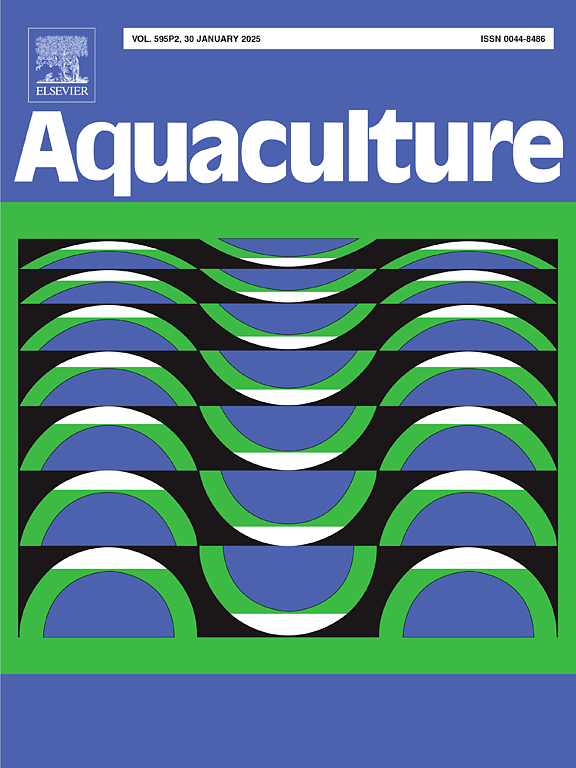综合转录组学和代谢组学分析初步揭示了沙颡鱼鳃对盐度胁迫反应的分子机制
IF 3.9
1区 农林科学
Q1 FISHERIES
引用次数: 0
摘要
盐度是通过渗透调节影响淡水鱼生理功能的关键水环境因子。全盐鱼类小翼鱼(Micropterus salmoides)具有盐碱化养殖的潜力;然而,鳃适应长期盐度胁迫的分子机制仍然知之甚少。采用组织学、生理学、转录组学和代谢组学等方法,对盐度0‰(对照)、5‰、10‰条件下暴露24和48 d的鱼鳃进行了研究。组织学检查显示,盐度胁迫导致鳃片弯曲变形,5‰盐度时鳃丝变薄,10‰盐度时鳃片尖增大。此外,在24天和48天,盐暴露组的NKA活性均显著低于对照组。抗氧化活性(T-SOD、CAT、GSH-Px和T-AOC)在盐胁迫下先升高后降低。盐度诱导的鳃组织氧化应激破坏细胞膜脂质稳态,最终引发细胞凋亡。花生四烯酸代谢被确定为介导氧化应激反应的关键途径。综合多组学分析表明,肾素-血管紧张素系统(RAS)在长期盐度适应中起关键作用,皮质醇、醛固酮和前列腺环素合成酶(PGIS)参与渗透调节。碳水化合物和脂质代谢的激活为适应盐度胁迫提供了必需的能量。综上所述,本研究为全盐鱼类耐盐机制的研究提供了新的思路,并为盐碱养殖的发展提供了有价值的信息。本文章由计算机程序翻译,如有差异,请以英文原文为准。
Integrative transcriptomic and metabolomic analyses reveal preliminary molecular mechanisms of gills response to salinity stress in Micropterus salmoides
Salinity is a key aquatic environmental factor that affects the physiological functions of freshwater fishes through osmotic regulation. Micropterus salmoides, A euryhaline fish, shows potential for saline aquaculture; however, the molecular mechanisms underlying gill acclimation to long-term salinity stress remain poorly understood. This study investigated M. salmoides gills in salinity 0 ‰ (control), 5 ‰, 10 ‰ exposed for 24 and 48 days using histological, physiological, transcriptomic, and metabolomic approaches. Histological examination revealed that salinity stress induced curvature and deformation of gill lamellae, thinning of gill filaments at 5 ‰ salinity, while lamellar tips exhibited enlargement at 10 ‰ salinity. Furthermore, NKA activity was significantly lower in the salinity-exposed groups than in the control group at both 24 and 48 days. Antioxidant activities (T-SOD, CAT, GSH-Px and T-AOC) initially increased but subsequently decreased under salinity stress. Salinity-induced oxidative stress in the gill tissues disrupted cellular membrane lipid homeostasis, ultimately triggering apoptosis. Arachidonic acid metabolism was identified as a key pathway mediating oxidative stress responses. Integrated multi-omics analyses demonstrated that the renin-angiotensin system (RAS) plays a pivotal role in long-term salinity adaptation, with cortisol, aldosterone, and prostacyclin synthase (PGIS) contributing to osmotic regulation. Activation of carbohydrate and lipid metabolism supplied essential energy for salinity stress adaptation. In conclusion, this study provides novel insights into salinity tolerance mechanisms in euryhaline fishes and offers valuable information for developing M. salmoides saline aquaculture.
求助全文
通过发布文献求助,成功后即可免费获取论文全文。
去求助
来源期刊

Aquaculture
农林科学-海洋与淡水生物学
CiteScore
8.60
自引率
17.80%
发文量
1246
审稿时长
56 days
期刊介绍:
Aquaculture is an international journal for the exploration, improvement and management of all freshwater and marine food resources. It publishes novel and innovative research of world-wide interest on farming of aquatic organisms, which includes finfish, mollusks, crustaceans and aquatic plants for human consumption. Research on ornamentals is not a focus of the Journal. Aquaculture only publishes papers with a clear relevance to improving aquaculture practices or a potential application.
 求助内容:
求助内容: 应助结果提醒方式:
应助结果提醒方式:


